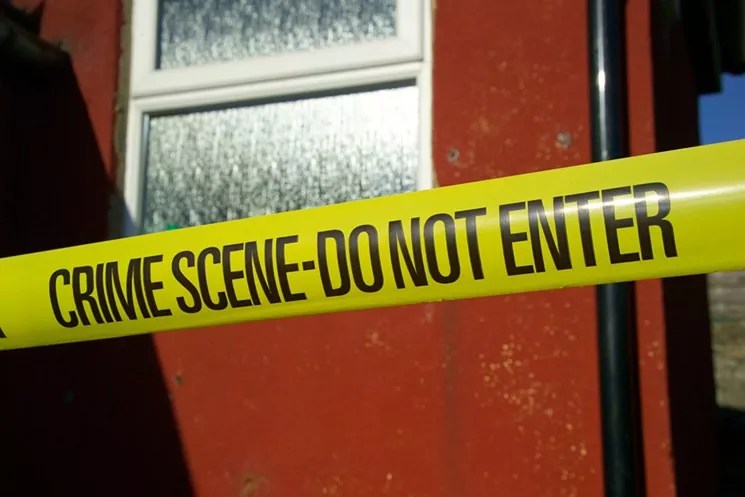
Flickr via Ian Britton

Audio By Carbonatix
New data from the FBI shows that most violent and property crimes are declining nationally, but clearance rates for serious crimes like murder and rape remain relatively low. Meanwhile, many more people were arrested for marijuana offenses in 2018 than were arrested for violent crimes.
The latest crime statistics were published by the FBI on Monday in its annual crime report. The report collects crime data from more than 16,000 police departments across the country in an attempt to identify the trends.
Nationally, there were fewer violent crimes and property crimes in 2018 than there were in 2017, with the exception of rape. In Phoenix, the violent crime rate dropped 5.3 percent from 2017 to 2018. The murder rate in Phoenix also fell by 12.7 percent from 2017 to 2018. Statewide, violent crimes (except rape) and property crimes have also dropped, with 47 fewer murders occurring in Arizona in 2018 than in 2017.
Rape is the only violent crime for which reports have steadily increased in recent years, though some experts say this may be because more people are coming forward to report rape, rather than because more rapes are occurring. Until 2013, the FBI defined rape as “the carnal knowledge of a female forcibly and against her will.”
The FBI currently defines rape as “penetration, no matter how slight, of the vagina or anus with any body part or object, or oral penetration by a sex organ of another person, without the consent of the victim.” Attempted rapes are also included. When the definition changed, the number of reported rapes included in the FBI’s crime data also increased.
Nationally, 62.3 percent of murders were cleared, while 33.4 percent of rapes were cleared. While the murder rate fell by 6.2 percent nationally, marking the second year in a row that the murder rate has declined, the clearance rate (which measures how many cases police close by arrest or exceptional means, which includes simply identifying a probable suspect) for violent crimes is still very low.
In Arizona, those numbers are even worse. While the FBI does not make city or statewide clearance data publicly available, a 2018 investigation by ProPublica found that the Phoenix Police Department’s clearance rate for rape is just 11 percent. In Tucson, the second most-populated city in Arizona, the clearance rate for rape is just 6 percent.

Murders decreased in Phoenix in 2018 compared to the previous year, from 157 to 132.
FBI
Of the 64 police departments ProPublica collected data from, Tucson and Phoenix had some of the lowest clearance rates, particularly when compared to similarly sized cities like Philadelphia, where the rape clearance rate was 51 percent.
As is the case nationally, reported rapes in most major Arizona cities have gone up, according to the new stats from the FBI. In the past five years, the number of reported rapes in Phoenix has risen from 1,006 to 1,086. In Tucson, that number has gone up by about 80 reported rapes as well, from 422 to 504.
The rate of reported rapes in Mesa, the state’s third-largest city, has actually trended somewhat downward in recent years, from 252 in 2014 to 238 in 2018. Chandler’s reported rapes have more than doubled in the same time frame, from 60 to 146, but that apparent trend also may be due to significant changes in reporting practices, and a far more expansive definition of rape adopted by police departments in 2014. Gilbert saw a similar spike since then, from 27 to 75, while Tempe went up from 103 to 176. The increased number of reported rapes, historically one of the most under-reported crimes, may also have something to do with the fact that more people are feeling empowered to report sexual assault following the Me Too movement.
Murders, meanwhile, did go down in Phoenix in 2018 compared to the previous year, from 157 to 132. While that is still somewhat of an increase from 2013, when there were 118 murders, it still represents a significant drop from 2006, when there were 234 murders in Phoenix, reflecting the national drop in violent crime rates.
There were 47 murders in Tucson, an increase from recent years from 30 murders in 2016 and 31 in 2015.
More murders isn’t great news for a police department that can barely solve half of the few that occur. Data collected by the Washington Post for a project on unsolved homicides shows that from 2010 to 2017, only 52 percent of Tucson’s 351 homicides resulted in an arrest.
During that same time period in Phoenix, 45 percent of the 914 homicides that occurred resulted in arrest – slightly below the national average of 50 percent for that time frame.
Murder in other cities in the Valley, like Mesa and Chandler, remain generally low. Scottsdale, Glendale, Chandler, Gilbert, Tempe, and Peoria are all in the single digits, while Mesa had 17 murders in 2018 (a drop from 23 in 2017).
While police departments like Phoenix and Tucson leave nearly half of all murders – and almost all rapes – unsolved, police in Arizona arrested over 600 people last year for “curfew and loitering law violations,” 567 people for “vagrancy,” defined by the FBI as violating laws “prohibiting persons from remaining in an area or place in an idle and aimless manner,” and a whopping 32,272 people for “drug abuse violations.”
Throughout the state, 281 people were arrested for murder in 2018 (out of 369 crimes committed), and 328 people were arrested for rape in 2018 (out of 3,638 committed).
Nationally, 86 percent of arrests for “drug abuse violations” were for drug possession. Thirty-seven percent of those arrests were for marijuana possession.
It is the third straight year that marijuana arrests have increased, according to the FBI data. More people were arrested for marijuana in 2018 (663,367 arrests) than were arrested for violent crimes (521,103 arrests). All of this comes at a time when 11 states have legalized recreational marijuana, 33 states have legalized medical marijuana, and prosecutors across the country are declining to prosecute marijuana possession cases.